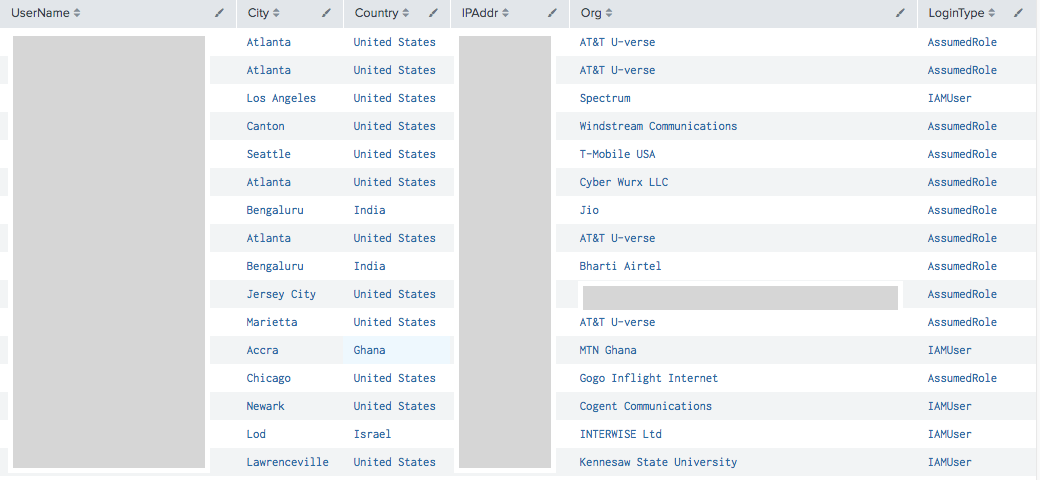This post is contains all the queries from my talk SEC339 at re:Invent 2019. Yes, it is very similar to the talk I gave at re:Inforce.
The focus is on the Preparation & Identification aspects of the SANS Incident Response framework.
Preparation
The tools we need here are:
- Centralized CloudTrail
- Centralized GuardDuty
- Antiope
- Splunk.
CloudTrail
We centralize all our CloudTrail events from all our accounts into a single bucket. Splunk then points at the bucket and all our events are automatically ingested. CloudTrail is deployed at account creation by a CloudFormation template created by the security team.
Anatomy of a CloudTrail Event
This is what a generic CloudTrail event looks like:
{
"awsRegion": "us-east-1",
"eventName": "CreateBucket",
"eventSource": "s3.amazonaws.com",
"eventTime": "2019-06-09T15:37:18Z",
"eventType": "AwsApiCall",
"recipientAccountId": "123456789012",
"requestParameters": {},
"responseElements": null,
"sourceIPAddress": "192.168.357.420",
"userAgent": "[S3Console/0.4, aws-internal/3 aws-sdk-java/1.11.526
Linux/4.9.152-0.1.ac.221.79.329.metal1.x86_64 OpenJDK_64-Bit_Server_VM/25.202-b08
java/1.8.0_202 vendor/Oracle_Corporation]",
"userIdentity": {
"accessKeyId": "ASIATFNORDFNORDAZQ",
"accountId": "123456789012",
"arn": "arn:aws:sts::123456789012:assumed-role/assume-rolename/first.last@company.com",
"type": "AssumedRole"
}
}
A few key elements from a threat hunting perspective are:
eventName- This is the API Call madeeventSource- This is the AWS service (ec2, s3, lambda, etc)sourceIPAddress- IP address the call came from. It’s either an IP, or an AWS service likecloudformation.amazonaws.comuserIdentity.arn- Depending on type, the attributes of userIdentity change, but the arn is always presentuserIdentity.type- TypicallyIAMUserorAssumeRolerecipientAccountId- AWS Account ID the event was for. In this post they will all be 123456789012
requestParameters will change based on the API call. Sometimes there are useful filters in there.
GuardDuty
We leverage the GuardDuty Master/Member account concept. New accounts are discovered by Antiope and auto-invited into the master. We have cross account role that allows the security account to accept the invitation. As a global company, detectors are deployed in all AWS Regions. A CloudWatch Event is configured in the GuardDuty master account to invoke a lambda that will push the event to a Splunk HTTP Event Collector (HEC) cluster.
Like CloudTrail, Centralizing GuardDuty is a must for a large multi-account environment. Luckily GuardDuty has a master-account/member-account model that works across AWS Organizations. We leverage that to pull all GuardDuty findings, in every region, back to that region in a central GuardDuty account. From there a CloudWatch Event fires an AWS Lambda which pushes the finding to a Splunk HTTP Event Collector (HEC). The master account has this Detector/CWE/Lambda combination deployed in all AWS Regions. We maintain a redundant HEC cluster.
The code we use to manage this is available here
Sample Finding
{
"id": "d5b0fccf-THIS-IS-UNIQUE-PER-FINDING",
"account": "987654321098", <-- SECURITY ACCOUNT
"time": "2019-06-14T14:07:29Z",
"region": "us-east-1",
"detail": {
"schemaVersion": "2.0",
"accountId": "123456789012", <-- MONITORED ACCOUNT
"region": "us-east-1",
"partition": "aws",
"type": "Recon:EC2/PortProbeUnprotectedPort", <-- AWS CLASSIFICATION
"severity": 2,
"resource": {}, <-- either AccessKey or Instance
"service": {
"action": {
"actionType": "PORT_PROBE",
"portProbeAction": {
"portProbeDetails": [
{
"localPortDetails": {"port": 22, "portName": "SSH"},
"remoteIpDetails": {
"ipAddressV4": "116.112.202.89", <--USEFUL
"organization": {"org": "China Unicom Neimeng"}, <-- ALSO USEFUL
"country": {"countryName": "China"},
"city": {"cityName": "Ordos"},
"geoLocation": {"lat": 39.6, "lon": 109.7833 }
}
}
],
"blocked": false
}
}
"resourceRole": "TARGET",
"additionalInfo": {"threatName": "Scanner", "threatListName": "ProofPoint"},
},
"createdAt": "2019-02-27T23:41:19.160Z",
"updatedAt": "2019-06-14T13:59:41.042Z",
"title": "Unprotected port on EC2 instance i-fnord is being probed.",
"description": "EC2 instance has an unprotected port which is being probed by a known malicious host."
}
Antiope
I’ve written about Antiope before. It functions both as an inventory gathering tool, and it helps us discover and manage our several hundred AWS accounts.
Splunk
Splunk is the central tool we use for all log gathering and analysis.
Identification
Alternate session title: So now I have three billion compressed json blobs in S3. What’s next?
Strategy
- CloudTrail to detect events we know are bad
- GuardDuty to correlate events in CloudTrail
- GuardDuty to find events in VPCFlow logs & DNS logs we can’t see
- CloudSploit for misconfigured resources
- Antiope to manage, AWS accounts find where a resource is
Root Login Detection
The first basic query is to find all the root login attempts. The query looks like:
index=cloudtrail "userIdentity.type"=Root AND eventName=ConsoleLogin
And the response:
{
"additionalEventData": {
"LoginTo": "https://console.aws.amazon.com/console/home?state=hashArgs%23&isauthcode=true",
"MFAUsed": "No",
"MobileVersion": "No"
},
"eventName": "ConsoleLogin",
"eventSource": "signin.amazonaws.com",
"eventType": "AwsConsoleSignIn",
"responseElements": {
"ConsoleLogin": "Success"
},
"sourceIPAddress": "192.168.357.420",
"userAgent": "Mozilla/5.0 (Macintosh; Intel Mac OS X 10_14_5) AppleWebKit/537.36 (KHTML, like Gecko)
Chrome/74.0.3729.169 Safari/537.36",
"userIdentity": {
"accessKeyId": "",
"accountId": "123456789012",
"arn": "arn:aws:iam::123456789012:root",
"principalId": "123456789012",
"type": "Root"
}
}
In this particular event, we see MFAUsed is No. Since we have compliance monitoring around MFA on root, and notification of discovery of new accounts, we can correlate this event back to a new account being created and our cloud team putting MFA on the account for the first time.
IAM Login with no MFA
The purpose of this query is to see who is logging as an IAMUser without supplying MFA. In theory there should be none of these, so if we see one, we want to reach out to the account owner to understand why this user isn’t required to have MFA. This query is adapted from the CIS Foundations Benchmark for AWS.
index=cloudtrail ConsoleLogin "additionalEventData.MFAUsed"!=Yes "userIdentity.type"=IAMUser
| dedup userIdentity.arn sourceIPAddress
| table "userIdentity.accountId" "userIdentity.arn" sourceIPAddress "responseElements.ConsoleLogin"
Additionally, if the sourceIPAddress seems suspect we can bump the urgency of the escalation to the account owner.
This is that same query but including the City and Country of the login:
index=cloudtrail ConsoleLogin "additionalEventData.MFAUsed"!=Yes "userIdentity.type"=IAMUser
| dedup userIdentity.arn sourceIPAddress
| iplocation sourceIPAddress
| search Country!="United States"
| table "userIdentity.accountId" "userIdentity.arn" sourceIPAddress,
City, Country "responseElements.ConsoleLogin"
Unauthorized Calls
This one is also part of the CIS Benchmarks. Here it is translated to Splunk and aggregated across all the accounts.
index=cloudtrail errorCode="AccessDenied" OR errorCode="UnauthorizedOperation"
| stats count by eventName userIdentity.arn
Failed IAM Console Logins
index=cloudtrail errorMessage="Failed*" eventName=ConsoleLogin sourceIPAddress!="357.420.*"
| iplocation sourceIPAddress
| stats count by sourceIPAddress, Country
Another CIS Benchmark query. Here we can exclude our known IP ranges, and decorate the results with the Country of origin.
Expensive Amazon EC2 detection
This one will find all instances that are launched (for all instance types) that are 10xlarge or bigger. If big money instances are not your norm, this alarm can find abuse or devs who don’t know better.
index=cloudtrail eventName=RunInstances
| regex "requestParameters.instanceType"=\d{2}xlarge
| stats count by requestParameters.instanceType
Wall of Shame

This query shows who (userIdentity.arn) opened a security group (eventName=AuthorizeSecurityGroupIngress) to the world (cidrIp"="0.0.0.0/0") on port 22 or 3389 (fromPort=22 OR fromPort=3389).
index=cloudtrail eventName = AuthorizeSecurityGroupIngress
"requestParameters.ipPermissions.items{}.ipRanges.items{}.cidrIp"="0.0.0.0/0"
"requestParameters.ipPermissions.items{}.fromPort"=22
OR "requestParameters.ipPermissions.items{}.fromPort"=3389
| stats count by userIdentity.arn
IAM User Creation by Country
A common method of persistence is to create a new IAM User. This query returns the list of countries where a CreatUser was done. We exclude CloudFormation from these results.
index=cloudtrail eventName="CreateUser" sourceIPAddress!="*.amazonaws.com"
| iplocation sourceIPAddress
| stats count by Country

To dive deeper into what was happening in Hong Kong
index=cloudtrail eventName="CreateUser" sourceIPAddress!="*.amazonaws.com"
| iplocation sourceIPAddress | search Country="Hong Kong"
Note how we have to pipe back to search after piping to iplocation.
Recon
This finds all attempts to GetCallerIdentity that didn’t come from the US. GetCallerIdentity is a common recon call that returns the IAMUser name and account number for a API Key and Secret.
index=cloudtrail eventName=GetCallerIdentity "userIdentity.type"=IAMUser
| iplocation sourceIPAddress
| search Country!="United States"
| stats count by userIdentity.arn Country
Interesting CloudTrail Events
Here are a handful of other interesting eventNames you might want to search on. Many of these are based on the CIS Foundation Benchmarks for AWS.
CloudTrail:
- DeleteTrail
- StopLogging
- UpdateTrail
GuardDuty:
- DeleteDetector
- DeleteMembers
- DisassociateFromMasterAccount
- DisassociateMembers
- StopMonitoringMembers
KMS:
- ScheduleKeyDeletion
- DisableKey
AWS Config Service:
- StopConfigurationRecorder
- DeleteDeliveryChannel
- PutDeliveryChannel
- PutConfigurationRecorder
Security Groups & NACLs:
- AuthorizeSecurityGroupEgress
- RevokeSecurityGroupEgress
- CreateNetworkAcl
- DeleteNetworkAcl
- CreateNetworkAclEntry
- DeleteNetworkAclEntry
- ReplaceNetworkAclEntry
- ReplaceNetworkAclAssociation
VPCs:
- AttachInternetGateway
- CreateVpcPeeringConnection
- AcceptVpcPeeringConnection
- CreateClientVpnEndpoint
GuardDuty: Count of Finding Types
Simple Query to get a summary of all the GuardDuty findings in a period of time. This is a good place to start.
index=guardduty | dedup id | stats count by detail.type
Because findings can re-occur, I always dedup by the finding id.
GuardDuty: Logins From New IP Addresses
GuardDuty will learn where your users normally login from, and if it sees an unusual login, it will create a finding. As people travel this will generate several false-positives. However you can use this query to display all the findings.
index=guardduty "detail.type"="UnauthorizedAccess:IAMUser/ConsoleLogin"
"detail.service.action.awsApiCallAction.remoteIpDetails.organization.org"!="EXCLUDE YOUR ORG HERE"
| dedup "detail.service.action.awsApiCallAction.remoteIpDetails.ipAddressV4"
| rename "detail.service.action.awsApiCallAction.remoteIpDetails.country.countryName" as Country
| rename "detail.service.action.awsApiCallAction.remoteIpDetails.city.cityName" as City
| rename "detail.service.action.awsApiCallAction.remoteIpDetails.organization.org" as Org
| rename "detail.resource.accessKeyDetails.userName" as UserName
| rename "detail.resource.accessKeyDetails.userType" as LoginType
| rename "detail.service.action.awsApiCallAction.remoteIpDetails.ipAddressV4" as IPAddr
| table UserName City Country IPAddr Org LoginType

Note how we leverage rename to provide heading columns that aren’t 40 char long.
You can add this before the first dedup to exclude all the logins that occurred inside the US
"detail.service.action.awsApiCallAction.remoteIpDetails.country.countryName"!="United States"
GuardDuty: Credential Exfiltration
Probably the most critical GuardDuty alert you can receive is UnauthorizedAccess:IAMUser/InstanceCredentialExfiltration. This indicates EC2 Instance Profile credentials have been used outside of AWS.
index=guardduty UnauthorizedAccess:IAMUser/InstanceCredentialExfiltration
GuardDuty: RDP Brute Forcing
This query displays key info about the RDP Brute Force GuardDuty finding. The data about the attacker is buried in the action.networkConnectionAction.remoteIpDetails, except for the port which is inside the localPortDetails.
index=guardduty "detail.type"="UnauthorizedAccess:EC2/RDPBruteForce"
| dedup id
| rename "detail.service.action.networkConnectionAction.remoteIpDetails.country.countryName" as Country
| rename "detail.service.action.networkConnectionAction.remoteIpDetails.city.cityName" as City
| rename "detail.service.action.networkConnectionAction.remoteIpDetails.organization.org" as Org
| rename "detail.service.action.networkConnectionAction.localPortDetails.port" as Port
| rename "detail.service.action.networkConnectionAction.remoteIpDetails.ipAddressV4" as IPAddr
| rename "detail.resource.instanceDetails.instanceId" as instanceId
| table City Country Org IPAddr Port instanceId

This is the difference between “you have a vulnerability” and “you are under attack”
PrivilegeEscalation:IAMUser/AdministrativePermissions
This one is an IAM User call where the information is in awsApiCallAction and not in networkConnectionAction like the RDP Example.
index=guardduty "detail.type"="PrivilegeEscalation:IAMUser/AdministrativePermissions"
| dedup id
| rename "detail.service.action.awsApiCallAction.remoteIpDetails.country.countryName" as Country
| rename "detail.service.action.awsApiCallAction.remoteIpDetails.city.cityName" as City
| rename "detail.service.action.awsApiCallAction.remoteIpDetails.organization.org" as Org
| rename "detail.resource.accessKeyDetails.userName" as UserName
| rename "detail.resource.accessKeyDetails.userType" as LoginType
| rename "detail.resource.accessKeyDetails.principalId" as principalId
| rename "detail.service.action.awsApiCallAction.remoteIpDetails.ipAddressV4" as IPAddr
| table UserName City Country IPAddr Org LoginType principalId
Antiope: Wide Open Elastic Search Clusters
This one has come up thanks to several data leaks starting last fall.
index=antiope resourceType="AWS::ElasticSearch::Domain"
NOT configuration.VPCOptions.VPCId=*
NOT "supplementaryConfiguration.AccessPolicies.Statement{}.Condition.IpAddress.aws:SourceIp{}"=*
NOT "supplementaryConfiguration.AccessPolicies.Statement{}.Condition.IpAddress.aws:SourceIp"=*
NOT "supplementaryConfiguration.AccessPolicies.Statement{}.Condition.StringEquals.aws:SourceVpc"=*
| regex "supplementaryConfiguration.AccessPolicies.Statement{}.Principal.AWS"="\*"
| dedup resourceId
| table configuration.Endpoint resourceName awsAccountName
We’re looking for:
- ElasticSearch Domains
- Not in a VPC
- Not using SourceIP or SourceVpc Conditions
- Where the Resource Policy is AWS:* (anonymous access)
SourceIp can be a single value or an array, so it’s in the query twice.
Antiope: Support Cases
This gives you a quick view of all the open support cases in the organization:
index=antiope resourceType="AWS::Support::Case" | dedup resourceId
| table awsAccountName configuration.serviceCode configuration.categoryCode
configuration.status configuration.subject
And this one covers AWS account specific things:
index=antiope resourceType="AWS::Support::Case" "configuration.serviceCode"="customer-account"
| dedup resourceId
Splunk tends to re-ingest Antiope resources every time they’re queried. De-duplicating on the resourceId fixes this.
